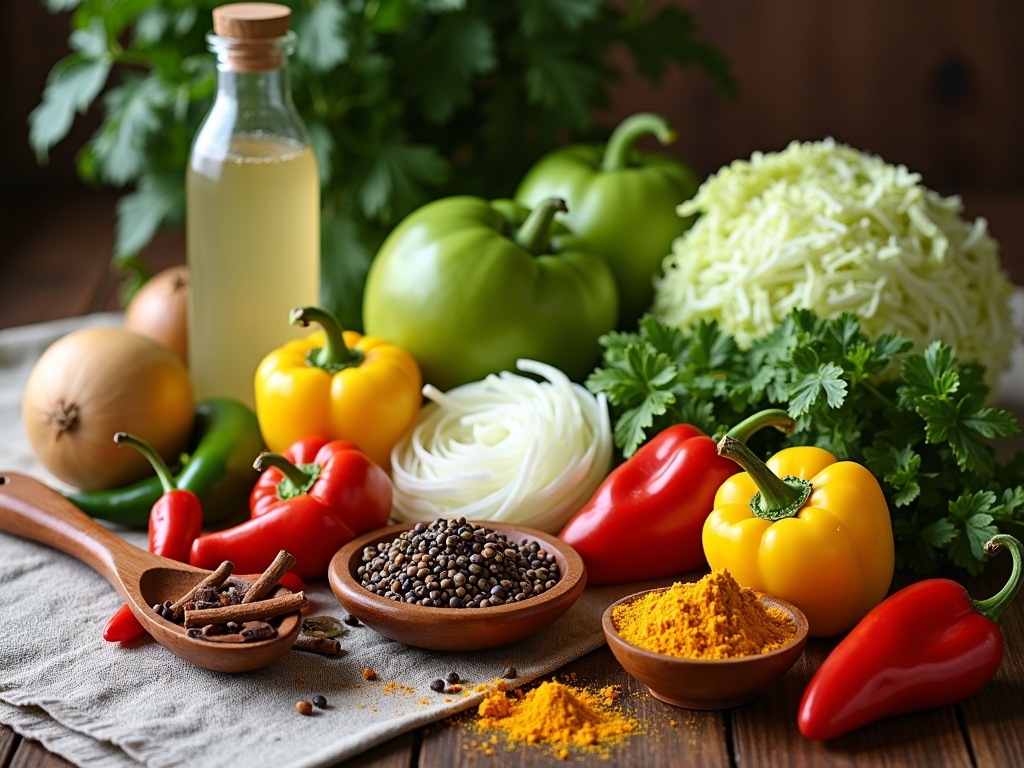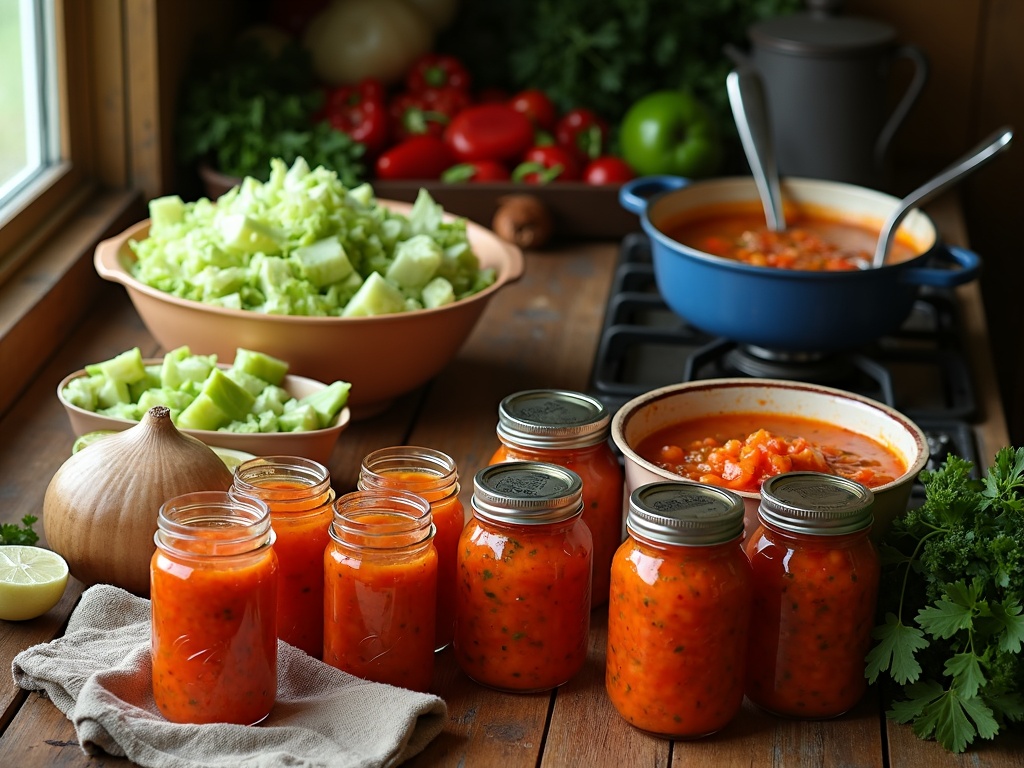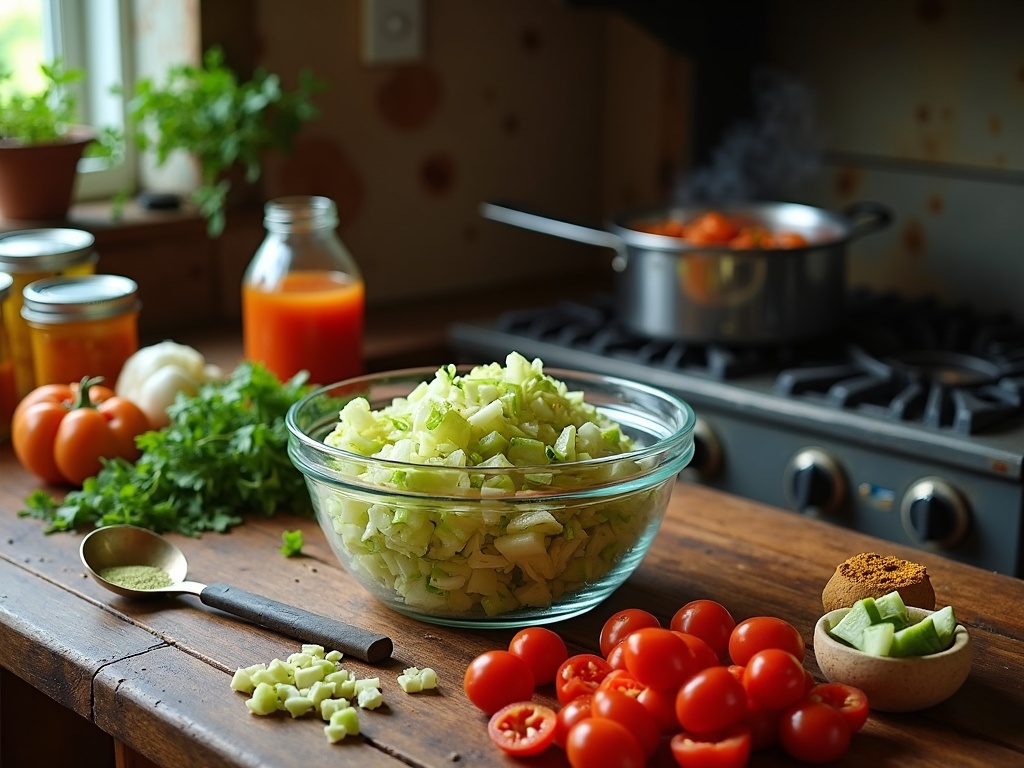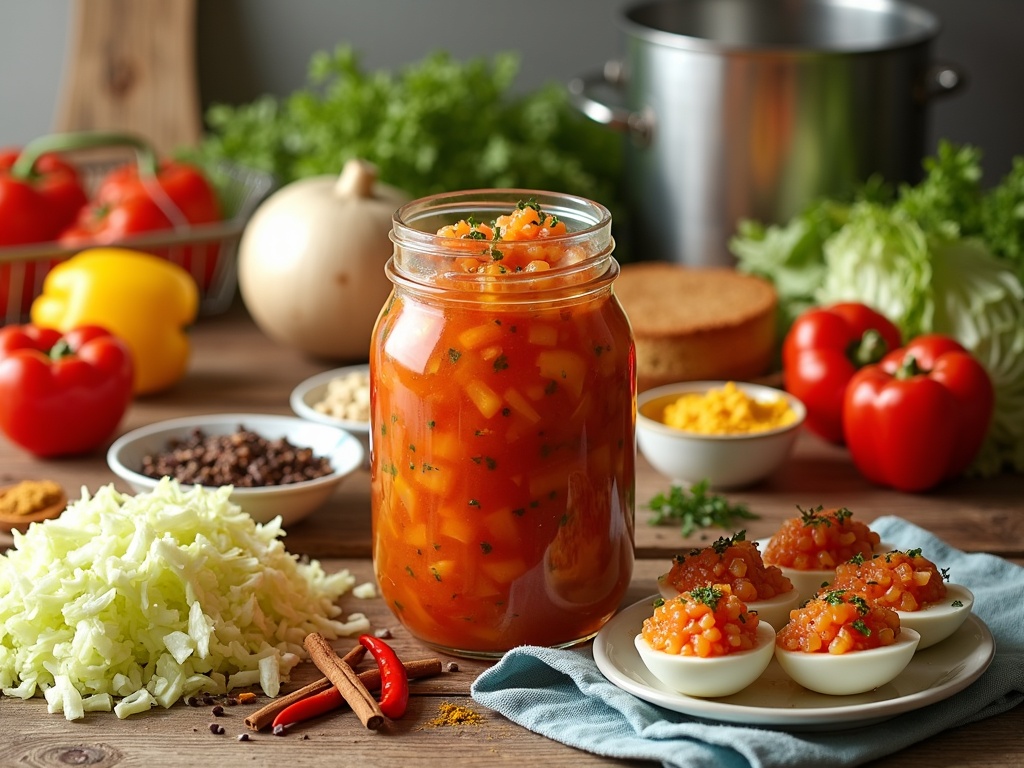Chow chow vegetable is a bright Southern vegetable relish that mixes green tomatoes, cabbage, peppers, and onions in a tangy, sweet pickling brine, making a flexible condiment with rich flavors.
This old-fashioned preservation technique turns simple vegetables into a crunchy, colorful addition that improves everything from beans and cornbread to sandwiches and charcuterie boards.
Find In This Article
Key Takeaways
- Chow chow balances sweet, tangy, sour, and spicy flavors while maintaining vegetable crispness even after pickling.
- Traditional ingredients include green tomatoes, cabbage, bell peppers, onions, and spices like mustard seeds and turmeric.
- Proper preparation requires uniformly chopping vegetables and drawing out moisture through salting before pickling.
- When properly canned, unopened chow chow lasts up to one year, while opened jars should be refrigerated and used within 2-3 weeks.
- Beyond hot dogs, chow chow elevates dishes like pulled pork, potato salad, sandwiches, cheese boards, and even deviled eggs.
What Makes Chow Chow Special
Chow chow holds a special place in Southern cuisine as a vibrant, tangy relish that transforms ordinary meals into something extraordinary. This traditional Southern condiment brings a perfect balance of sweet, tangy, sour, and spicy flavors that have delighted generations of food lovers. The unique combination of seasonal vegetables creates a condiment that’s more versatile than most people realize.
A Perfect Blend of Vegetables and Flavors
Chow chow starts with a colorful medley of chopped vegetables. Green tomatoes form the base of most traditional recipes, bringing a firm texture and tartness that can’t be replicated with ripe tomatoes. These are paired with crisp cabbage that adds both substance and a mild flavor that carries the stronger seasonings. The addition of onions introduces a sweet yet pungent element, while various peppers contribute both color and heat.
The magic happens when these vegetables come together through pickling. The vinegar-based brine infuses the vegetables with a signature tanginess that cuts through rich foods. What separates chow chow from other relishes is its perfect balance – it’s not overwhelmingly sweet like some cucumber relishes, nor is it one-dimensionally hot like some pepper-based condiments.
The texture of chow chow is also distinctive – the vegetables maintain their crispness even after pickling, creating a satisfying crunch with each bite. This textural element makes it particularly enjoyable when paired with softer foods like Mexican-inspired dishes or alongside tender beans.
Versatility Beyond the Ordinary
While most people think of chow chow as simply a hot dog topping, its uses extend far beyond this limited application. This versatile relish serves as:
- A transformative topping for burgers, elevating even basic patties with complex flavor
- The perfect companion to grilled sandwiches, particularly those featuring pork or smoked meats
- An unexpected but delicious addition to scrambled eggs or omelets
- A flavor-boosting mix-in for potato salad, tuna salad, or green bean salad
- A tangy garnish for black-eyed peas, pinto beans, or navy beans
- A vibrant accompaniment to cornbread or biscuits
The beauty of chow chow is how it complements rather than overwhelms. The balanced acidity cuts through fatty meats like pulled pork or fried cabbage dishes, while the hint of sweetness pairs beautifully with earthy foods like beans and root vegetables.
I’ve found that chow chow also makes an excellent addition to charcuterie boards, offering something unexpected alongside traditional meats and cheeses. It can even transform basic crackers and cream cheese into an impressive appetizer with minimal effort.
Unlike mass-produced condiments, homemade chow chow carries the signature of its maker. Some families prefer a sweeter version with more bell peppers, while others create fiery variations loaded with hot chilies. The ratios of vegetables can shift based on what’s available from the garden, making each batch slightly different. This adaptability has helped chow chow remain relevant across generations, with recipes being passed down and modified to suit changing tastes.
The condiment also represents the practical Southern tradition of preserving summer’s bounty. Green tomatoes that wouldn’t ripen before frost, end-of-season cabbage, and the last peppers from the garden all find their way into chow chow, creating a delicious way to extend the harvest through winter months. This connection to vegetable preservation techniques gives chow chow a deeper cultural significance beyond just its flavor.
Essential Ingredients You’ll Need
Gathering the right ingredients for chow chow vegetable relish is crucial to achieve that perfect balance of tangy, sweet, and spicy flavors. This Southern-inspired condiment relies on fresh produce and aromatic spices that work together to create its distinctive taste profile.
Fresh Produce and Spices
Green tomatoes form the backbone of traditional chow chow, providing a firm texture and tart flavor that can’t be replicated with ripe tomatoes. I always select firm, unblemished green tomatoes for the best results.
Cabbage adds crunch and body to the relish, with green cabbage being the preferred choice for its mild flavor and sturdy texture. It holds up well during the pickling process without becoming too soft. For additional color and flavor complexity, crisp cabbage varieties work particularly well in this recipe.
Bell peppers contribute sweetness and vibrant color. I typically use a mix of colors, though green bells maintain the traditional appearance of chow chow. These pair wonderfully with white onions, which provide a sharp, clean flavor that mellows beautifully during pickling.
For those who enjoy some heat, hot peppers are an optional but recommended addition. The amount can be adjusted based on your spice preference. Consider spicy pepper varieties to add that perfect kick to your chow chow.
The spice blend is what gives chow chow its distinctive flavor. Mustard seeds are non-negotiable, providing both texture and that characteristic mustardy bite. Turmeric contributes the golden color and earthy notes, while a balanced mix of salt and sugar creates the sweet-savory foundation.
White vinegar provides the acidic component necessary for both preservation and flavor. It’s sharper than apple cider vinegar, giving chow chow its trademark tanginess. For added depth, pickling spices typically include:
- Whole cloves
- Cinnamon sticks
- Celery seeds
- Allspice berries
- Black peppercorns
When selecting vegetables, the freshest produce yields the best results. I find that seasonal vegetables offer superior flavor and texture compared to off-season options.
The beauty of chow chow is its versatility. You can adapt the recipe based on vegetable availability or personal preferences while maintaining the essential character of this beloved pickle relish. The combination of these fresh ingredients with aromatic spices creates a condiment that elevates everything from hot dogs to garden-fresh salads.

How to Make Your Chow Chow
Creating homemade chow chow is a straightforward process that yields delicious results. I’ve broken down the steps to help you craft this classic Southern relish with confidence.
Preparing the Vegetables
The first step in making chow chow is proper vegetable preparation. I chop all vegetables into small, uniform pieces — this consistency ensures even cooking and better flavor distribution throughout the relish. Typically, I aim for pieces about 1/4 inch in size.
After chopping, I sprinkle the vegetables with salt and place them in a colander over a bowl. This crucial step draws out excess moisture overnight, concentrating flavors and helping preserve the relish. Make sure to cover the vegetables and refrigerate them during this draining period.
Cooking and Canning
Once the vegetables have drained properly, I’m ready to create the flavorful brine. In a large pot, I combine vinegar, sugar, and spices — this mixture forms the tangy base that gives chow chow its distinctive flavor. The balance of sweet and sour is what makes this relish so versatile.
Next, I add the drained vegetables to the simmering brine, stirring occasionally to ensure even cooking. The vegetables need to cook until they’re tender but still retain some crunch — usually about 10–15 minutes. You’ll notice the colors becoming vibrant as they absorb the spiced brine.
When the vegetables reach the perfect tenderness, I pack the hot chow chow into properly sterilized jars, leaving appropriate headspace at the top. This headspace is essential for proper sealing during processing.
The final step involves processing the filled jars in a water bath canner — typically for about 10 minutes for half-pint jars. This processing step is critical for food safety and ensures your homemade vegetable relish can be stored safely for months to come.
After processing, I remove the jars and allow them to cool completely on a towel-lined counter. The satisfying “ping” sound as each lid seals confirms your chow chow is properly preserved. Once cooled, I label each jar with the date and enjoy this colorful condiment throughout the year alongside beans, greens, cornbread, or as a zesty addition to sandwiches and hot dogs.

Storage and Shelf Life
Storing chow chow vegetable relish properly ensures you’ll enjoy its vibrant flavors for months to come. I’ve found that proper storage techniques not only extend its shelf life but also maintain its quality and taste profile over time.
Unopened Storage
Properly canned chow chow should be kept in a cool, dark place away from direct sunlight and heat sources. Your pantry, cellar, or kitchen cabinet works perfectly for this purpose. The ideal storage temperature ranges between 50-70°F (10-21°C). When stored correctly in sealed jars, chow chow can maintain its quality for up to one year without losing flavor or nutritional value.
Here are key considerations for storing unopened chow chow:
- Ensure jars are sealed tightly with no signs of bulging or leakage
- Store away from appliances that generate heat
- Keep jars off the floor to prevent temperature fluctuations
- Arrange jars so older batches are used first
- Label jars with the date of canning for easy tracking
After Opening
Once I’ve opened a jar of chow chow, I always transfer it to the refrigerator immediately. Refrigeration significantly slows down the spoilage process by inhibiting bacterial growth. An opened jar of chow chow remains good for 2–3 weeks when properly refrigerated.
Always use a clean utensil when serving chow chow to prevent introducing bacteria into the jar. I notice that the best way to extend freshness is to ensure the lid is tightly sealed after each use. If you notice any unusual odor, appearance, or taste, it’s safest to discard the relish rather than risk consuming spoiled food.
For longer-term storage, you could consider preserving fresh vegetables by making smaller batches of chow chow that you’ll consume within a reasonable timeframe. This approach helps maintain the vibrant flavors and crisp texture that make vegetable side dishes like chow chow so appealing.
If you’re planning to make a large batch of chow chow, consider using smaller jars so you can open just what you need without compromising the shelf life of the entire batch. This storage method works especially well if you enjoy versatile vegetable sides but don’t use them daily.

Serving Suggestions
Chow chow vegetable relish is incredibly versatile in the kitchen. This tangy, slightly sweet condiment adds a burst of flavor and texture to numerous dishes. I’ve discovered several delicious ways to incorporate this Southern classic into everyday meals that might surprise you.
Classic Pairings
Chow chow and pinto beans share a long history in Southern cuisine. The acidic, spicy notes of chow chow perfectly complement the earthy richness of pinto beans. I add a generous spoonful on top of a bowl of hot beans for an instant flavor enhancement. The combination creates a beautiful balance that transforms simple beans into a memorable dish.
Beyond beans, chow chow works wonderfully as a topping for classic American favorites. A dollop of this colorful relish on hot dogs adds crunch and tang that elevates them beyond the basic ketchup and mustard. Similarly, hamburgers gain new dimension when topped with chow chow — the pickled vegetables cut through the richness of the meat while adding texture contrast.
No Southern barbecue is complete without proper sides, and chow chow earns its place on the plate. I serve it alongside pulled pork, ribs, or smoked chicken as a palate-cleansing counterpoint to rich, smoky flavors. The acidity in chow chow helps balance the fattiness of barbecued meats, making each bite more enjoyable than the last.
Creative Applications
Sandwich spreads take on new life with the addition of chow chow. I drain a small amount of chow chow and mix it into mayonnaise for a flavor-packed spread that works beautifully on turkey, ham, or roast beef sandwiches. Here are some specific sandwich ideas that showcase chow chow’s versatility:
- Southern-style ham biscuits with chow chow spread
- Grilled cheese sandwiches with a layer of well-drained chow chow
- Egg salad with finely chopped chow chow mixed in
- Wraps with cream cheese and chow chow as the base
Potato salad transforms from ordinary to extraordinary with chow chow mixed in. The sweet and tangy flavors infuse the entire dish, while cabbage and other vegetables add textural interest. I fold a half-cup of well-drained chow chow into my traditional potato salad recipe just before serving for best results.
For an unexpected twist, I’ve found that chow chow makes a delightful addition to deviled eggs. The pickled vegetables provide both flavor and visual appeal when mixed into the yolk filling. This approach works especially well with cabbage-heavy chow chow varieties that complement the richness of the egg yolks.
Chow chow also shines when paired with other vegetable side dishes, creating a flavorful medley. I particularly enjoy serving it alongside roasted root vegetables or as part of a vegetable plate with other Southern classics like collard greens and corn pudding.
For something completely different, try using chow chow as a topping for roasted carrots or other sweet vegetables. The contrast between caramelized vegetables and the bright, tangy relish creates an interesting flavor dynamic that guests rarely expect but always appreciate.
Cheese boards gain Southern flair with a small bowl of chow chow included among the offerings. The relish pairs surprisingly well with sharp cheddar, smoked gouda, and even milder cheeses like havarti. This unexpected addition to a traditional appetizer spread always sparks conversation and delights guests.
Finally, don’t overlook chow chow as a topping for vegetable-focused main dishes. A spoonful atop vegetable stews, bean burgers, or grain bowls provides a pop of flavor and texture that turns simple dishes into memorable meals.
Common Mistakes to Avoid
Making chow chow vegetable relish seems straightforward, but certain pitfalls can compromise both flavor and food safety. I’ve seen these errors repeatedly in my canning adventures and want to help you dodge them for perfect results every time.
Preparation and Processing Errors
Cutting vegetables inconsistently ranks among the most frequent mistakes. When chopping cabbage, peppers, onions, and other vegetables for chow chow, uniformity is crucial. Uneven pieces cause irregular texture and inconsistent pickling. Some chunks remain too crunchy while others turn mushy. I recommend dicing all vegetables to approximately 1/4-inch pieces for the best texture and even pickling.
Skipping the salting step can severely impact your final product. This critical process draws out excess moisture from vegetables, creating the perfect texture and enhancing preservation. Without salting, your chow chow might become watery and lose its characteristic crunch. To do this correctly:
- Place chopped vegetables in a large non-reactive bowl
- Sprinkle with salt (typically 1/4 cup per 8 cups of vegetables)
- Let stand for 4–6 hours or overnight
- Rinse thoroughly and drain well before proceeding
Not properly sterilizing jars potentially introduces harmful bacteria. Before filling with chow chow, I always wash jars in hot, soapy water, then place them in boiling water for at least 10 minutes. The lids and bands need similar treatment but shouldn’t be boiled—just warmed in hot water to keep the sealing compound intact.
Insufficient processing time represents another safety hazard. After filling and capping jars, they must be processed in a water bath canner for the correct duration—usually 10–15 minutes for chow chow, depending on jar size and altitude. This step kills harmful microorganisms and creates a vacuum seal. Cutting this time short can lead to spoilage or even foodborne illness.
Selecting quality vegetables makes all the difference in canning. Using overripe vegetables often results in a mushy texture and can affect the preservation process. I always choose firm, fresh vegetables at their peak ripeness for the best flavor and texture. Avoid using produce that shows any signs of decay, soft spots, or discoloration.
Additional missteps to watch for include:
- Altering vinegar proportions in recipes (the acidity level is vital for safe preservation)
- Overpacking jars (always leave proper headspace, typically 1/4 inch for chow chow)
- Using table salt instead of pickling or canning salt (table salt contains anti-caking agents that cloud the brine)
- Reducing sugar content (sugar contributes to preservation and overall balance)
- Reusing old lids (the sealing compound becomes unreliable after one use)
Choosing complementary vegetables matters too. Traditional chow chow typically contains green tomatoes, cabbage, onions, and peppers. If substituting ingredients, maintain similar moisture content and acidity levels for safety.
Temperature fluctuations during storage can affect quality as well. Once processed and sealed, store jars in a cool, dark place with consistent temperatures. Exposure to light and heat gradually degrades flavor, color, and texture over time.
By avoiding these common mistakes, your homemade chow chow vegetable relish will maintain its vibrant flavor, appealing texture, and most importantly, remain safe to enjoy with your favorite vegetable side dishes throughout the year. The attention to detail makes all the difference between a mediocre condiment and a standout homemade preservation that friends and family will request again and again.
Tips for Perfect Chow Chow
Making delicious chow chow vegetable relish isn’t complicated, but a few key techniques can transform your results from good to exceptional. I’ve learned these tricks through years of preserving vegetables, and they make all the difference in creating that perfect balance of flavors and textures.
Selection and Preparation
Starting with the right ingredients forms the foundation of outstanding chow chow. I always select firm, unripe green tomatoes for their distinct tangy flavor and ability to maintain structure during cooking. Unlike ripe tomatoes, these won’t break down into mush, instead providing that characteristic chunky texture that makes chow chow and cabbage dishes so satisfying.
The vegetables you choose should be fresh and crisp. When I shop for cabbage, peppers, onions, and cucumbers, I look for specimens without soft spots or wilting. This freshness directly impacts both flavor and texture in the final relish. I’ve found that processing vegetables immediately after harvesting or purchasing yields the brightest flavors and crunchiest texture.
Cutting vegetables into uniform sizes isn’t just about appearance—it ensures even pickling and consistent texture throughout your vegetable relish. I aim for ¼-inch dice for most ingredients, creating balanced bites where no single vegetable dominates.
Perfecting the Process
The draining step often gets rushed, but I’ve learned it’s crucial for developing proper texture. After salting your chopped vegetables, allow them at least 4–6 hours (or overnight for best results) to drain properly. This removes excess moisture that would otherwise dilute flavors and create a watery finished product.
I process my chow chow immediately after cooking, while the mixture is still hot. This creates a proper vacuum seal in the jars and helps preserve the vegetable flavors at their peak. Waiting even 15–20 minutes can compromise both safety and quality.
The beauty of homemade chow chow is that you can customize the spice profile to your preference. I start with the basic recipe then adjust:
- For extra heat: Add more red pepper flakes or a diced jalapeño
- For warmth: Increase turmeric or mustard seed
- For sweetness: Add a touch more sugar
- For tanginess: Add a splash of apple cider vinegar
Remember that flavors will mellow slightly during storage, so I make the seasoning slightly stronger than my ultimate preference. This approach ensures that when I open a jar three months later, the vegetable side dish has perfectly balanced flavors.


